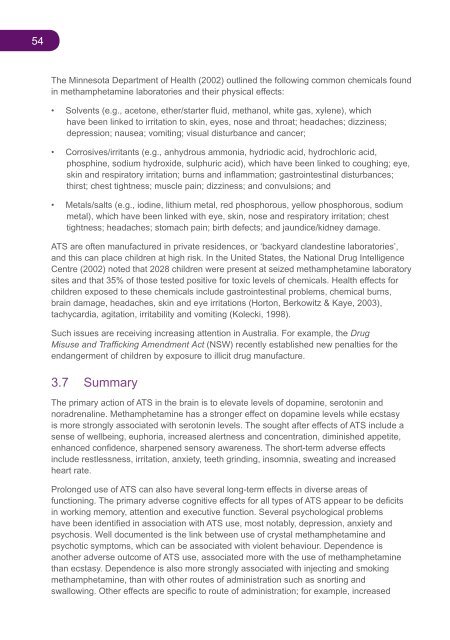National Amphetamine-Type Stimulant Strategy Background Paper
National Amphetamine-Type Stimulant Strategy Background Paper
National Amphetamine-Type Stimulant Strategy Background Paper
You also want an ePaper? Increase the reach of your titles
YUMPU automatically turns print PDFs into web optimized ePapers that Google loves.
54<br />
The Minnesota Department of Health (2002) outlined the following common chemicals found<br />
in methamphetamine laboratories and their physical effects:<br />
• Solvents (e.g., acetone, ether/starter fluid, methanol, white gas, xylene), which<br />
have been linked to irritation to skin, eyes, nose and throat; headaches; dizziness;<br />
depression; nausea; vomiting; visual disturbance and cancer;<br />
• Corrosives/irritants (e.g., anhydrous ammonia, hydriodic acid, hydrochloric acid,<br />
phosphine, sodium hydroxide, sulphuric acid), which have been linked to coughing; eye,<br />
skin and respiratory irritation; burns and inflammation; gastrointestinal disturbances;<br />
thirst; chest tightness; muscle pain; dizziness; and convulsions; and<br />
• Metals/salts (e.g., iodine, lithium metal, red phosphorous, yellow phosphorous, sodium<br />
metal), which have been linked with eye, skin, nose and respiratory irritation; chest<br />
tightness; headaches; stomach pain; birth defects; and jaundice/kidney damage.<br />
ATS are often manufactured in private residences, or ‘backyard clandestine laboratories’,<br />
and this can place children at high risk. In the United States, the <strong>National</strong> Drug Intelligence<br />
Centre (2002) noted that 2028 children were present at seized methamphetamine laboratory<br />
sites and that 35% of those tested positive for toxic levels of chemicals. Health effects for<br />
children exposed to these chemicals include gastrointestinal problems, chemical burns,<br />
brain damage, headaches, skin and eye irritations (Horton, Berkowitz & Kaye, 2003),<br />
tachycardia, agitation, irritability and vomiting (Kolecki, 1998).<br />
Such issues are receiving increasing attention in Australia. For example, the Drug<br />
Misuse and Trafficking Amendment Act (NSW) recently established new penalties for the<br />
endangerment of children by exposure to illicit drug manufacture.<br />
3.7 Summary<br />
The primary action of ATS in the brain is to elevate levels of dopamine, serotonin and<br />
noradrenaline. Methamphetamine has a stronger effect on dopamine levels while ecstasy<br />
is more strongly associated with serotonin levels. The sought after effects of ATS include a<br />
sense of wellbeing, euphoria, increased alertness and concentration, diminished appetite,<br />
enhanced confidence, sharpened sensory awareness. The short-term adverse effects<br />
include restlessness, irritation, anxiety, teeth grinding, insomnia, sweating and increased<br />
heart rate.<br />
Prolonged use of ATS can also have several long-term effects in diverse areas of<br />
functioning. The primary adverse cognitive effects for all types of ATS appear to be deficits<br />
in working memory, attention and executive function. Several psychological problems<br />
have been identified in association with ATS use, most notably, depression, anxiety and<br />
psychosis. Well documented is the link between use of crystal methamphetamine and<br />
psychotic symptoms, which can be associated with violent behaviour. Dependence is<br />
another adverse outcome of ATS use, associated more with the use of methamphetamine<br />
than ecstasy. Dependence is also more strongly associated with injecting and smoking<br />
methamphetamine, than with other routes of administration such as snorting and<br />
swallowing. Other effects are specific to route of administration; for example, increased

















